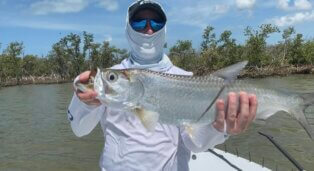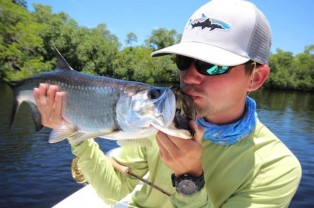Florida Keys Juvenile Tarpon Fishing – Chasing Juvenile Tarpon in the Mangroves
When it comes to pure fishing excitement, Florida Keys Juvenile Tarpon Fishing for juvenile tarpon in the mangrove islands is hard to beat. These silver-sided acrobats, ranging from 1 to 30 pounds, offer heart-pounding strikes, spectacular jumps, and unforgettable battles—all in the calm, scenic backwaters of the Florida Keys. If you’re looking for an inshore flats fishing adventure aboard our 18’ Flats Skiff, targeting juvenile tarpon should be at the top of your list.

When & Where to Find Juvenile Tarpon
While juvenile tarpon can be caught year-round, the action truly peaks when water temperatures rise above 80°F with warm, humid air and light-to-flat-calm winds. These conditions light up the shallow bays, creeks, and ponds tucked deep into the mangrove maze.
In these waters, tarpon often travel in small schools, crashing into bait balls of tiny minnows or chasing shrimp across the surface. On special days, you may be lucky enough to witness a shrimp hatch—an incredible spectacle where tarpon are everywhere, busting shrimp at the surface with explosive strikes.
Tackle & Techniques for Light Tackle Spinning
For spin fishing, we love Shimano Saragossa 5000 series reels spooled with 10–15 lb. green Suffix 832 braided line and topped with a 20 lb. fluorocarbon leader. This setup delivers both the casting distance and fish-fighting power needed in tight mangrove channels.
One of our go-to lures is the Bass Assassin 5″ soft plastic Shad bait rigged on a VMC 3/0–5/0 wide-gap worm hook. We rig these weedless so we can cast deep into mangrove pockets without snagging roots or branches. The key is a slow, steady retrieve with the occasional twitch—tarpon love to ambush a bait that looks wounded.
Fly Fishing for Juvenile Tarpon
If you prefer fly fishing, a 7–8 weight fly rod with a floating line is perfect. Accurate casts of 40 feet or more are a big advantage when sight-fishing. In the clear shallows, you’ll often see fish roll or flash just under the surface—getting your fly tight to the shoreline or right in front of a rolling fish is critical. Shrimp and baitfish patterns in natural colors work best, especially during a hatch.
Pro Tips for Success
-
Be Patient: Tarpon often short-strike. Keep stripping until you feel solid weight.
-
Watch for Bubbles: After a tarpon rolls, bubbles can show its direction of travel.
-
Act Fast: Once you see a fish roll, cast quickly to where it’s headed.
-
Stay Quiet: Poling or drifting quietly increases your chances in these calm waters.
Regulations & Conservation
Juvenile tarpon fishing in Florida is strictly catch-and-release. Fish over 40 inches must stay in the water unless you have a tarpon tag for a record attempt.
Handle fish gently:
-
Keep gills in the water as much as possible.
-
Avoid dragging them onto the boat or shore.
-
Have your camera ready for quick photos.
We also proudly support habitat restoration and conservation efforts through organizations like Bonefish & Tarpon Trust and Captains for Clean Water. Healthy habitats mean healthy tarpon populations for generations to come.
Ready to experience Florida Keys Juvenile Tarpon Fishing at its finest? Step aboard our 18’ Flats Skiff and join us for an unforgettable day chasing these silver kings in some of the most remote and beautiful waters the Keys have to offer.
Book your trip today and let’s get you hooked up with your very own acrobatic juvenile tarpon!

 IntelligenceStorm
IntelligenceStorm